|
|
|
Sort Order |
|
|
|
Items / Page
|
|
|
|
|
|
|
| Srl | Item |
| 1 |
ID:
117630
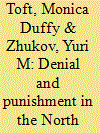

|
|
|
|
|
| Publication |
2012.
|
| Summary/Abstract |
A growing literature on the subnational diffusion of armed conflict rests on the proposition that political violence triggers more violence, in the same locality and elsewhere. Yet state efforts to contain such uprisings remain largely unexplored, theoretically and empirically. Drawing on a mathematical model of epidemics, we formalize the logic of conflict diffusion and derive conditions under which state coercion might limit the spread of insurgent violence. Using a new dataset of insurgent and government violence in Russia's North Caucasus from 2000 to 2008, we evaluate the relative effectiveness of four coercive strategies: (1) denial, which manipulates the costs of expanding insurgent activity to new locations, (2) punishment, which manipulates the costs of sustained fighting in contested areas, (3) denial and punishment, which does both, and (4) no action, which does neither. We find denial to be most effective at containing insurgent violence. Punishment is least effective, and even counterproductive. Not only does such a strategy fail to prevent the spillover of violence to new locations, but it may amplify the risk of continued fighting in contested areas. In the Caucasus, denial is found to be the least inflammatory counter-insurgency option for Russia. For it to succeed, Russia should physically isolate centers of insurgent activity from regions of nonviolence and avoid the temptation of punitive reprisals.
|
|
|
|
|
|
|
|
|
|
|
|
|
|
|
|
| 2 |
ID:
094411
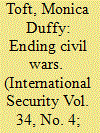

|
|
|
|
|
| Publication |
2010.
|
| Summary/Abstract |
Since 1990, negotiated settlements have become the preferred means for settling civil wars. Historically, however, these types of settlements have proven largely ineffective: civil wars ended by negotiated settlement are more likely to recur than those ending in victory by one side or the other. A theoretical and statistical analysis of how civil wars end reveals that the type of ending influences the prospects for longer-term outcomes. An examination of all civil war endings since 1940 finds that rebel victories are more likely to secure the peace than are negotiated settlements. A statistical analysis of civil wars from 1940 to 2002 and the case of Uganda illustrate why rebel victories result in more stable outcomes. Expanding scholarly and policy analysis of civil war termination types beyond the current default of negotiated settlement to include victories provides a much larger set of cases and variables to draw upon to enhance understanding of the conditions most likely to support long-term stability, democracy, and prosperity.
|
|
|
|
|
|
|
|
|
|
|
|
|
|
|
|
| 3 |
ID:
074298
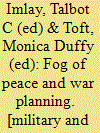

|
|
|
|
|
| Publication |
London, Routledge, 2006.
|
| Description |
xi, 282p.
|
| Standard Number |
0415366976
|
|
|
|
|
|
|
|
|
|
|
|
Copies: C:1/I:0,R:0,Q:0
Circulation
| Accession# | Call# | Current Location | Status | Policy | Location |
| 051806 | 355.0335/IML 051806 | Main | On Shelf | General | |
|
|
|
|
| 4 |
ID:
049178
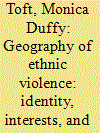

|
|
|
|
|
| Publication |
Princeton, Princeton University Press, 2003.
|
| Description |
xii, 226p.
|
| Standard Number |
0691113548
|
|
|
|
|
|
|
|
|
|
|
|
Copies: C:1/I:0,R:0,Q:0
Circulation
| Accession# | Call# | Current Location | Status | Policy | Location |
| 047210 | 303.6/TOF 047210 | Main | On Shelf | General | |
|
|
|
|
| 5 |
ID:
077104
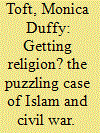

|
|
|
|
|
| Publication |
2007.
|
| Summary/Abstract |
From 1940 to 2000, Islam was involved in a disproportionately high number of civil wars compared with other religions, such as Christianity or Hinduism. To help explain the overrepresentation of Islam in these wars, this article introduces a theory of "religious outbidding." The theory holds that embattled political elites will tender religious bids when they calculate that increasing their religious legitimacy will strengthen their chances of survival. In combination with three overlapping factors-the historical absence of an internecine religious civil war similar to the Thirty Years' War in Europe, proximity of Islam's holiest sites to Israel and large petroleum reserves, and jihad (i.e., defense of Islam as a religious obligation), religious outbidding accounts for Islam's higher representation in religious civil wars. The article includes a statistical analysis of the role of religion in civil wars and tests the logic of the argument of religious outbidding in the case of Sudan's two civil wars
|
|
|
|
|
|
|
|
|
|
|
|
|
|
|
|
| 6 |
ID:
127888
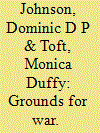

|
|
|
|
|
| Publication |
2013.
|
| Summary/Abstract |
In international relations, unlike the natural sciences, there are few fundamental principles or laws. The world map, however, reveals at least one iron law of global politics: human territoriality. Almost every inch of the globe is partitioned into exclusive and bounded spaces that "belong" to specific groups of humans. Any that is not-such as Kashmir, Jerusalem, and the South China Sea-remains hotly contested. Throughout history, territory has led to recurrent and severe conflict. States are prepared to go to war, and individuals are prepared to die, even over land with little intrinsic value. While such behavior presents a puzzle for international relations theory, a broader evolutionary perspective reveals that territorial behavior has the following three characteristics: (1) it is common across the animal kingdom, suggesting a convergent solution to a common strategic problem; (2) it is a dominant strategy in the "hawk-dove" game of evolutionary game theory (under certain well-defined conditions); and (3) it follows a strategic logic, but one calibrated to cost-benefit ratios that prevailed in our evolutionary past, not those of the present. These insights generate novel predictions about when territorial conflict is more or less likely to occur in international relations.
|
|
|
|
|
|
|
|
|
|
|
|
|
|
|
|
| 7 |
ID:
189966
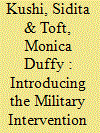

|
|
|
|
|
| Summary/Abstract |
While scholars have made many claims about US military interventions, they have not come to a consensus on main trends and consequences. This article introduces a new, comprehensive dataset of all US military interventions since the country’s founding, alongside over 200 variables that allow scholars to evaluate theoretical propositions on drivers and outcomes of intervention. It compares the new Military Intervention Project (MIP) dataset to the current leading dataset, the Militarized Interstate Disputes (MID). In sum, MIP doubles the universe of cases, integrates a range of military intervention definitions and sources, expands the timeline of analysis, and offers more transparency of sourcing through historically-documented case narratives of every US military intervention included in the dataset. According to MIP, the US has undertaken almost 400 military interventions since 1776, with half of these operations undertaken between 1950 and 2019. Over 25% of them have occurred in the post-Cold War period.
|
|
|
|
|
|
|
|
|
|
|
|
|
|
|
|
| 8 |
ID:
140169


|
|
|
|
|
| Summary/Abstract |
This article offers the first disaggregated, quantitative comparison of Islamist and nationalist violence, using new data from Russia's North Caucasus. We find that violence by Islamist groups is less sensitive to government coercion than violence by nationalist groups. Selective counterinsurgency tactics outperform indiscriminate force in suppressing attacks by nationalists, but not Islamists. We attribute this finding to rebels’ support structure. Because Islamist insurgents rely less on local support than nationalists, they are able to maintain operations even where it is relatively costly for the local population to support them. These findings have potentially significant implications for other contemporary conflicts in which governments face both types of challenges to their authority and existing political order.
|
|
|
|
|
|
|
|
|
|
|
|
|
|
|
|
| 9 |
ID:
076985
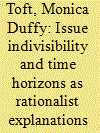

|
|
|
|
|
| Publication |
2006.
|
| Summary/Abstract |
This paper focuses on two rationalist explanations for war: issue indivisibility and time horizons. It argues that both types of bargaining problems have not only been undertheorized in the international relations literature, but that a non-trivial proportion of the violence witnessed since the end of the Cold War may be explained by these obstacles to non-violent conflict resolution. The paper includes a discussion of nationalism and religious belief and how these relate to issue indivisibility and infinite time horizons. To illustrate the key arguments, it uses the case of Russia's two most recent wars in Chechnya.
|
|
|
|
|
|
|
|
|
|
|
|
|
|
|
|
| 10 |
ID:
114674
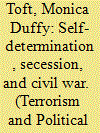

|
|
|
|
|
| Publication |
2012.
|
| Summary/Abstract |
The end of the Cold War led to the creation of almost two dozen new states, resulting from groups that advanced claims based on the legitimacy of national self-determination. These claims ranged from modestly increased autonomy to secession and independent statehood. As a result, and because a number of these claims escalated to violence, scholarly research into self-determination and secession has increased tremendously over the past two decades, with scholars examining the fate of these movements and associated violence and wars, from onset to the termination of associated violence and wars. This article assesses the state of the academic literature as it relates to the links between self-determination, secession, and civil wars. It begins with a discussion of what exactly is understood by such key concepts as ethnicity, self-determination, secession, and secessionist war. It then turns to the conditions and factors that have been identified in the literature to explain the emergence of self-determination and secession and why violence and war become potential outcomes.
|
|
|
|
|
|
|
|
|
|
|
|
|
|
|
|
| 11 |
ID:
128866
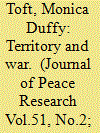

|
|
|
|
|
| Publication |
2014.
|
| Summary/Abstract |
In the past four decades scholars have produced a large literature on the relationship between territory and war. What is clear is that territory has been and will continue to be a core issue in explaining the escalation and onset of war and that territory has peculiar features that impact whether and how a conflict evolves and ends, and the nature of the peace that follows. These dynamics have received significant consideration theoretically and empirically. Although research initially centered on interstate wars, focus broadened to include intrastate or civil wars. On the methodological side, scholarship has taken a quantitative shift. The article concludes that both theorizing and empirical testing have become increasingly sophisticated.
|
|
|
|
|
|
|
|
|
|
|
|
|
|
|
|
|
|
|
|
|